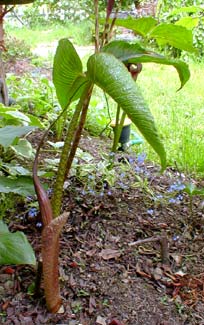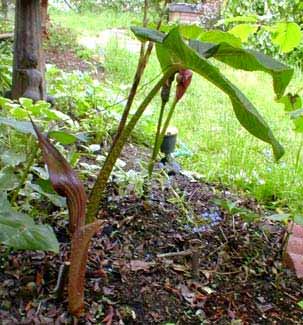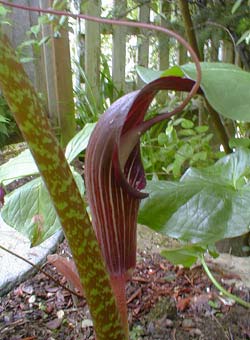
Double-Whip
Cobra Lily
strangest of flowers
Growing near an "Italian Lords & Ladies" Arum is the exotic Arisaema speciosum, next to two other very large Himalayan species of jack-in-the-pulpits, A. griffithii & A. nepenthoides.
This species grows native from Nepal & Northeast India to south central China. It has a dark purple to chocolate spathe striped or marked white.
The mottled or purple-blotched leaf stem bears a huge tropical-looking shiny palmate leaf, divided to look a bit like three leaves with reddish brown margins.
 It is called a "Double-Whip" cobra lily because it has two tongues. The first is at the pointed tip of the hood or spathe, the "tongue" common to Arisaemas generally.
It is called a "Double-Whip" cobra lily because it has two tongues. The first is at the pointed tip of the hood or spathe, the "tongue" common to Arisaemas generally.But much stranger is an unexpected tongue that extends from the head of the spadix or jack. This is a long string visible even before the jack or the hood or the leaf are well-developed.
The jack is white on the bottom, purple on the top, extremely visible since the point of the spathe is uplifted to reveal the interior. From the spadix's head the thin string of a whip extends to a couple feet length, though winding so that it remains close to the stem.
This second tongue or stringy filament will either dangle to the ground, or what is very common, the developing leaf will pick up the thread & carry it upward way above the spathe as the leaf unfolds & the stem gets taller.
 The three photos, from early to late in May respectively, show the string upheld on the triple-leaf. I can only assume that the purpose of this fantastic filament is to make the spadix more accessible to pollinators who'll climb along the string, which is poking out of the developing spathe even before you can tell it's a flower. You can see further portraits of this species on the A. speciosum page of the Pulpit Gallery.
The three photos, from early to late in May respectively, show the string upheld on the triple-leaf. I can only assume that the purpose of this fantastic filament is to make the spadix more accessible to pollinators who'll climb along the string, which is poking out of the developing spathe even before you can tell it's a flower. You can see further portraits of this species on the A. speciosum page of the Pulpit Gallery.It prefers dappled shade. It can sometimes require a mulch for protection in winter but is generally very hardy.
Usually an easy species to grow in zones 7 & 8, it can be strict about soil conditions. Its ground must be extremely well-draining or the large cylindrical tuber & roots may rot. Yet consistent moisture is also required.
The spathe lasts three or four weeks then dies back. If it develops a seed head, that will ripen slowly, lasting until the start of autumn.
The very decorative leaf will generally last until summer's end unless the soil gets too dry or the stem gets battered. Harsh weather does sometimes break the larger varieties of jack-in-the-pulpits, so that a leeside windbreak of shrubbery is useful both to protect it from high winds & to provide it with its requisit shade.
White Chinese Cobra Lily,
Arisaema candidissimum